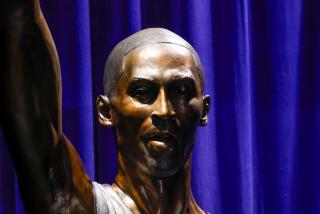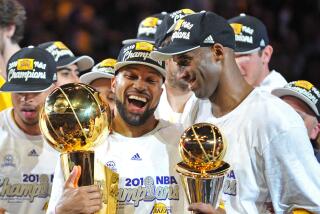Who’s Next?
Kobe, en fuego, puts himself out in the nick of time.
Kobe, Kobe, burning bright.
It was like acetylene aflame, the brightest light from the hottest fire, as Kobe Bryant ascended to yet another level, at least until his string of 40-point games took on a life of its own.
It was about basketball when it started, then survival as he tried to keep the Lakers from falling back when Shaquille O’Neal went out, but by games No. 8 and 9, Bryant’s ego was plainly involved, before he realized where this was heading. Happily for all concerned, when he saw that No. 10 wasn’t happening, he didn’t chase it out the door, he just let it go.
If the hype around such an obscure record was overblown, its real significance lay in what it revealed about the relentless, ever-evolving and still only 24-year-old Bryant.
Every season seems to bring a new Kobe, striking out boldly in a different direction, encountering new adventures, so that we’re always wondering, “Who is he now?”
As usual, for him, the game is the easy part, it’s everything else that has to be sorted out. As he noted matter-of-factly after the streak ended, “Oh, I can play better basketball.”
Of course, he has always said that. The amazing thing is, he hasn’t been proven wrong yet.
“I’m depressed, to tell you the truth,” Jerry Reynolds, personnel director of the arch-rival Sacramento Kings, said last week. “I have nothing but admiration for the young man, but at this stage of my life, I didn’t need to see this happen....
“I’m hoping maybe he’ll lose interest in the game. Maybe he could play baseball. I think we could get the River Cats [Sacramento’s minor league team] to sign him. He can live at my house, if he wants to.”
In Indianapolis, Pacer President Donnie Walsh watched Bryant getting 52 in the double-overtime victory over the Rockets, and raved about it for days.
“I know guys get 50,” Walsh said. “I was at a game [as a Denver assistant in 1978] when David Thompson got 73 or something. But this 52 was a real 52. I was telling Isiah [Thomas, Pacer coach], the guy was making one big shot after another, the whole fourth quarter and two overtimes....
“This is the kind of stuff legends are made of.”
Unfortunately for the Lakers, as the chants of “Kobe!” and “MVP!” wafted down -- even in the Delta Center -- and the media heavies flew in to interview him, it was also becoming the kind of stuff problems are made of.
They went 7-2 in Bryant’s nine 40-point games. He shot 49% and 47% on three-pointers. However, they looked solid at the beginning, then wobbly at the end in unimpressive victories over the Trail Blazers and SuperSonics.
The role players, whose production is modest but key, were all but sidelined as the sideshow became the show. They stuck to the house line -- it was OK -- but O’Neal’s studied responses (“Kobe’s all about making history”) suggested there were limits.
Bryant will make his share of NBA history. Of course, it will be better if it inspires awe, without snickers.
You Robin, Me Batman,
or Is It Vice Versa?
“Everyone compares [Bryant] to Michael Jordan. Well, he’s just 24. I know one thing, he’s better than Jordan was when he was 24.”
-- Jerry Reynolds
Of course, we’ve seen Bryant make these quantum leaps before. In the beginning, they were annual.
It wasn’t only Bryant’s skill level that impressed Jerry West in 1996, but his poise -- which was always confused with maturity, a very different quality -- and commitment.
Kobe would finish the season as one kind of player and come back the next fall better than he’d ever been. The remarkable thing was, the people who knew him weren’t surprised.
“I think he’s Old School, personally,” says Clipper Coach Alvin Gentry, one of Bryant’s foremost admirers. “Old School with a touch of Generation X there....
“He works incredibly hard. I think the other thing that’s good about Kobe is that the guy works on things that he actually uses in the game.
“When I was at Detroit, [former Laker assistant] Larry Drew was my assistant and we often talked about players. And the one thing that Larry Drew said to me, the guy is a no-nonsense guy. A no-nonsense guy when it comes to working on his game. He takes it very seriously and he wants to be the best player in the world.”
Drew told other stories -- the one when then-coach Kurt Rambis tried to heal a split, calling a meeting in which teammates ripped Bryant, one after another ... and, by way of reply, Kobe went out that night and put up 25 shots.
Phil Jackson’s arrival in Bryant’s fourth season changed things. Jackson insisted that Bryant’s being all he could be couldn’t interfere with O’Neal’s being all he could be.
The principals thrashed it out, succeeding well enough to win three titles, but it wasn’t until the third season that Kobe could easily accept his role and Shaq could accept Kobe.
Nor was this happening in a vacuum. Bryant’s self-discovery extended throughout his life. He arrived as a prodigy who still lived with his parents, like Little Ricky-turned-rock-star in “Ozzie and Harriet.” By Kobe’s fourth season, his parents were back in Philadelphia. By his fifth, he was married and in this one, the couple just had a daughter.
Bryant gained immeasurably from Jackson’s tutelage, however oblique and painful it seemed at times, becoming the all-around player many doubted he would.
Jackson also told him there’d be a day when Shaq wouldn’t be Shaq anymore and he’d be the one who’d have to carry them. It simply arrived sooner than anyone expected.
Last spring, O’Neal was dinged up, last fall he was coming off surgery, and now he’s still trying to get back to what he was.
Suddenly, the Lakers needed everything Bryant had, which was inconvenient, since he was so deep in playmaker mode -- every season, it’s something else -- that it took Jackson six weeks and several conversations to persuade him to start firing.
When Kobe did open up, something else changed. A higher percentage than ever before went in.
Bryant’s outside shot has actually been a long time coming, because he works so hard and he wasn’t bad when he started, shooting 38% on three-pointers as an 18-year-old rookie.
However, after his rookie season, he hired a shooting coach, who taught him a new, jerky stroke that horrified the Laker staff in camp the next fall.
It didn’t just look funny, it didn’t go in as often. Bryant shot 34% on three-pointers in his second season, then dropped below 33% for the next four.
He was all the way down to 25% last season. A month into this one, he was at 28%.
In December, however, he warmed up to 38%, although with only 29 attempts.
On Jan. 7, he had that game against the SuperSonics in which he set NBA records, making nine three-pointers in succession and 12 overall.
With the modern emphasis on highlight-reel skills, of which Bryant has an abundance, there’s still nothing more important than the ability to shoot.
It was what took Jordan to his final level when he returned from baseball at 32, when people said he wasn’t the old high-flying Mike. Instead, he was a Larry Bird-level shot maker, which, it soon became clear, made him better than ever.
Now as Bryant’s confidence grew, his range deepened and his accuracy improved. He was a breakout waiting for the time and the opportunity to happen.
Of course, first Jackson had to talk him into shooting.
This was a conversation Jackson probably never expected to have, although if he’d learned one thing in four seasons here, it was that there was always something.
Bryant insists his choosing to shoot less wasn’t out of pique at teammates for not making shots, although he and O’Neal both showed their exasperation, leading to the famous Big Guy-Little Guy Debate, which Brian Shaw summed up in a one-liner:
“We’re getting our 30 points a game. It’s up to them to get their 70.”
In late January, the Lakers lost successive home games to the Warriors and Nets while Bryant took 31 shots. Jackson asked him to turn it up again. Kobe said he needed some adjustments in the offense. Phil made them.
Bryant went for 40 the next game, a victory at Phoenix, a landmark for the Lakers, who hadn’t beaten a winning team on the road.
He had 38 two nights later at Sacramento in the biggest victory of the season, additionally motivated by an accusation that he had been hung over, rather than ill last spring. Chastened, the Sacramento Bee apologized for publishing a local lawyer’s allegation.
He dropped 42 on the Jazz here, 35 on the Pacers in Indianapolis and 46 in the last game before the All-Star break, at New York. No one knew the show was only starting.
Wake Us When
You Need Us
Nor did many people know there was even a record for consecutive 40-point games.
There was no mention of it when Wilt Chamberlain posted 14 in a row in 1961, nor would anyone have cared much. His Warriors were drawing flies in their last season in Philadelphia, before moving to San Francisco, where Wilt put together another 14-game streak as they finished 31-49.
Nor was there much notoriety in 1986 when Jordan strung together nine 40s, while the Bulls went 3-6.
But that was (sigh) then and this is now, when the explosion of media platforms mandates a frantic search for programming and turns the mildly interesting into the sensational.
Of course, if everyone is acting as if this is important, how would you know otherwise?
Nos. 2 and 3 in Bryant’s streak came in romps over the lowly Nuggets, who keep the game slow enough to rank No. 5 in defense. Bryant hit them for 93 (42 and 51) in 62 minutes.
No. 4 was a sobering home loss to the Spurs. O’Neal took five rebounds, was booed by the home fans for watching another sail by and wound up leaving the lineup for three games. Bryant, playing on a sore right knee, stopped driving to the basket but still shot his way to 44 points.
Without Shaq, Kobe got 40 in No. 5, another sobering home loss, to the Knicks.
No. 6 was O’Neal’s ballyhooed rematch with Yao Ming. Shaq sat out and was roundly toasted. Bryant got 35 in regulation and 17 more in two overtimes for a grand total of 52 as the Lakers beat the Rockets. For the maraschino cherry atop the sundae, he posterized Yao with a driving dunk.
The next night in Salt Lake City, where the Lakers were considered mail-it-in underdogs, Bryant’s knee was so sore, they didn’t know if he’d play until game time. He limped out and scored 40 in a Laker upset to notch No. 7.
The thing was becoming big, and dysfunctional. O’Neal returned for Nos. 8 and 9, victories over the Trail Blazers and SuperSonics, but nothing worked right. Bryant took 66 shots against four assists.
In the second half against Seattle, he was four of 19 from the field and might not have reached 40 if Rashard Lewis hadn’t hit him with a body block, sending Kobe to the line when he was stuck on 39 with 23 seconds left.
After that, Bryant said he’d had to apologize to teammates, which was either a first or a welcome development.
“The younger Kobe never saw himself as wrong,” Rick Fox said later. “ ... Now he beats us to it. You don’t have to say, ‘What kind of shot was that?’ because he beats us to it.”
It’s not that Bryant renounced all interest in posting No. 10. He took 26 shots against the Clippers, several of the “heat-check” variety.
However, after sitting down with foul trouble early, he seemed to accept that this wasn’t his night. At the end, while the fans urged him to fire off a last barrage, he passed the ball. He dribbled out the last 20 seconds, smiling at Elton Brand, who was pretending he was coming out to double-team.
“A streak is a streak,” Bryant said. “It’s not going to win us any championships. To be mentioned in the breath with those guys is an honor in itself. The most important thing, obviously, is playing the game the right way.”
Courtside seat: $1,750 (Do you have 30-year mortgages on season packages?) Parking: $15. Seeing Bryant do the right thing in the end if you’re a Laker fan: Priceless.
More to Read
All things Lakers, all the time.
Get all the Lakers news you need in Dan Woike's weekly newsletter.
You may occasionally receive promotional content from the Los Angeles Times.







